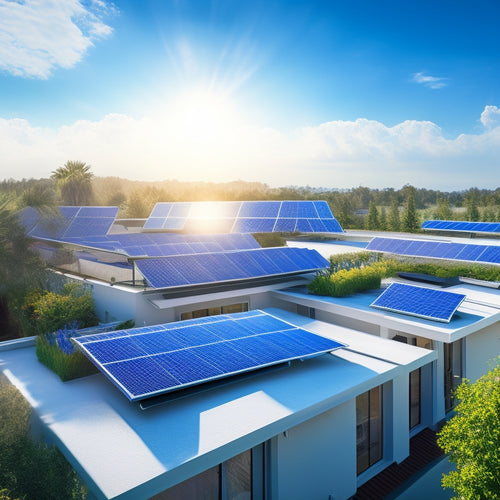
Best Small Home Panels for Maximum Energy Savings
Share
When it comes to maximizing energy savings in small homes, you need solar panels that combine high efficiency with compact design, optimizing energy production while minimizing space requirements. Consider panels with optimized width and length for energy production, and high-efficiency models that balance size and power output. Space-saving design options, like multifunctional furniture and compact appliances, can also enhance energy efficiency. By selecting the right panels and integrating them with energy-efficient design elements, you can unleash maximum energy savings in your small home. Explore the top-rated solar panels and energy-saving strategies to take your energy efficiency to the next level.
Key Takeaways
• Optimize panel width and length, frame thickness, and cell layout to maximize energy production in small homes.
• Select high-efficiency panels with compact designs, such as Tesla or Trina Solar, for space-constrained homes.
• Ensure proper panel tilt, orientation, and maintenance to maximize energy savings and minimize heat loss.
• Invest in smart home systems and energy audits to identify inefficiencies and optimize energy distribution in small homes.
• Consider DIY installation or refurbished panels to reduce costs and increase energy savings in small homes.
Top Rated Solar Panels Compared
When evaluating the best solar panels for your small home, you'll want to explore top-rated models from leading manufacturers, such as SunPower, Panasonic, and Tesla, which boast high efficiency rates and impressive warranties. These industry giants prioritize durability, guaranteeing their solar panels can withstand harsh weather conditions and last for decades. Solar panel durability is vital, as it directly impacts energy production and overall system longevity.
Look for panels with anodized aluminum frames, tempered glass, and robust mounting systems to ensure maximum resilience.
In addition to durability, panel warranty options are an essential factor in your decision-making process. Reputable manufacturers offer extensive warranties, typically ranging from 25 to 30 years, covering defects and performance guarantees. SunPower, for instance, offers a 25-year combined warranty, while Panasonic provides a 25-year product warranty and a 30-year performance warranty. Tesla's warranty options vary depending on the specific model, but they generally offer a 25-year warranty on their solar panels.
When comparing top-rated solar panels, prioritize manufacturers that offer thorough warranties, ensuring your investment is protected for years to come.
Energy Efficiency in Small Spaces
As you consider energy efficiency in your small space, you'll want to explore space-saving design options that maximize energy production.
You'll also need to develop energy efficiency strategies that minimize energy consumption, ensuring you get the most out of your system.
Space-Saving Design Options
By strategically incorporating space-saving design elements, you can maximize energy efficiency in compact homes without sacrificing functionality or comfort. In urban layouts, where space is a premium, every inch counts. By adopting a minimalist aesthetic, you can create a sleek and modern living space that not only looks great but also reduces energy consumption.
Here are some space-saving design options worth exploring:
-
Multifunctional furniture: Invest in furniture that serves multiple purposes, such as a storage ottoman or a desk with built-in shelving.
-
Vertical storage: Make the most of your ceiling height by installing floor-to-ceiling shelves or storage units.
-
Compact appliances: Choose energy-efficient appliances that are designed for small spaces, such as compact refrigerators or microwaves.
- Sliding doors and partitions: Replace traditional doors with sliding doors or partitions to create a more open and airy feel while saving space.
Energy Efficiency Strategies
To maximize energy efficiency in small spaces, you'll want to prioritize strategies that minimize heat loss, optimize natural light, and integrate energy-saving technologies into your design.
One key approach is to conduct an energy audit to identify areas of inefficiency in your home. This will help you pinpoint opportunities to seal air leaks, add insulation, and upgrade to energy-efficient appliances. By doing so, you'll reduce heat loss and minimize the strain on your HVAC system.
In a small home, every square foot counts, and smart home technologies can help you optimize energy usage. Consider installing smart thermostats, lighting systems, and appliances that can be controlled remotely and learn your energy usage habits. These features will enable you to make data-driven decisions about your energy consumption and adjust your habits accordingly.
Compact System Integration
In compact living spaces, integrating energy-efficient systems requires careful planning to maximize energy savings. You'll need to prioritize systems that serve multiple functions to minimize space requirements. This means opting for modular frameworks that can be easily scaled up or down depending on your energy needs.
To achieve peak energy efficiency, consider the following strategies:
-
Integrated circuits: Combine multiple energy-efficient systems into a single, compact unit to reduce space requirements and increase energy output.
-
Modular inverter systems: Use modular frameworks to connect multiple inverters, allowing you to scale up or down as needed.
-
Microgrid management: Implement microgrid management systems to optimize energy distribution and reduce energy waste.
- Smart sensors and monitoring: Install smart sensors and monitoring systems to track energy usage and identify areas for improvement.
Panel Size and Power Output
As you consider small home panels, you'll want to focus on efficient panel dimensions that maximize energy production in limited spaces.
It's important to strike a balance between panel size and power output to guarantee ideal energy harvesting.
Efficient Panel Dimensions
You'll find that optimizing panel size and power output is essential for maximizing energy savings, and a typical residential solar panel usually ranges from 250 to 370 watts. Efficient panel dimensions are vital to guarantee maximum energy production.
When it comes to panel frames, dimensional optimization is key. A well-designed frame can enhance energy output while reducing material costs.
Here are some key considerations for efficient panel dimensions:
-
Panel width and length: A larger panel size doesn't always mean more energy output. Optimizing width and length can reduce material costs while maintaining energy production.
-
Frame thickness and material: Thicker frames can provide added strength, but may increase material costs. Choosing the right material and thickness is crucial for the best energy production.
-
Cell layout and configuration: The arrangement of solar cells on the panel can greatly impact energy output. Optimizing cell layout and configuration can lead to increased energy production.
- Panel tilt and orientation: The angle and direction of your solar panels can greatly impact energy production. Optimizing panel tilt and orientation can ensure maximum energy savings.
Optimal Power Density
Achieving peak power density requires balancing panel size and power output to maximize energy savings, and a well-designed system can boost your energy production by up to 20%. You want to optimize your system's power density, as it directly affects your energy output and savings. To achieve this, you'll need to find the key spot between panel size and power output.
Energy densification is vital to maximizing your energy savings. By increasing the power output per unit area, you can generate more energy from a smaller panel size. This is important for small homes with limited roof space. Power optimization is also essential, as it ensures that your system operates at its maximum potential.
When selecting panels, look for high-efficiency models with high power outputs per unit area. A higher power density translates to more energy generated per square foot, resulting in greater energy savings. By optimizing your system's power density, you'll be able to generate more energy while minimizing your panel size.
This is especially important for small homes, where every square foot counts. By balancing panel size and power output, you'll be able to maximize your energy savings and reduce your carbon footprint.
Budget Friendly Solar Options
Your budget-friendly solar options begin with identifying the most cost-effective panel types, such as thin-film panels, which offer a lower upfront cost compared to traditional crystalline silicon panels.
To further reduce costs, consider the following:
-
Solar Incentives: Take advantage of government-backed incentives, such as tax credits or rebates, to offset the initial investment.
-
DIY Installation: Reduce labor costs by installing the panels yourself, or with the help of a friend or family member.
-
Used or Refurbished Panels: Explore the option of purchasing used or refurbished solar panels, which can be considerably cheaper than brand-new ones.
- Energy Efficiency Upgrades: Implement energy-efficient upgrades in your home, such as LED lighting or energy-efficient appliances, to maximize your energy savings.
Maximum Energy Savings Tips
Optimizing your solar panel system's performance requires careful planning and attention to detail, and by implementing the following strategies, you can maximize your energy savings.
One important step is to conduct an energy audit to identify areas of energy inefficiency in your home. This will help you pinpoint opportunities to reduce energy consumption and make the most of your solar panel system.
Consider investing in a smart home system that integrates with your solar panels, allowing you to monitor and control your energy usage in real-time. This will enable you to adjust your energy habits and maximize your energy savings.
Additionally, make sure that your solar panels are properly maintained and cleaned regularly to ensure peak performance. By following these tips, you can maximize your energy savings and get the most out of your solar panel system.
Best Brands for Small Homes
When shopping for solar panels for your small home, you'll want to explore brands that specialize in compact, high-efficiency systems designed specifically for limited roof spaces. These brands understand the unique challenges of small homes and offer tailored solutions to maximize energy savings.
Here are some top brands worth exploring:
-
Tesla: Known for their sleek, compact designs and seamless integration with Home Automation systems, Tesla's solar panels are a popular choice for small homes.
-
SunPower: Offering high-efficiency panels with built-in microinverters, SunPower's systems are ideal for small roofs with limited space.
-
Panasonic: With a focus on Luxury Features like high-efficiency cells and advanced temperature control, Panasonic's solar panels provide superior performance and durability.
- Trina Solar: Trina's compact, all-black panels are designed specifically for small homes, offering high-efficiency energy harvesting and sleek aesthetics.
These brands offer a range of options tailored to the unique needs of small homes, ensuring you can maximize your energy savings and enjoy a more sustainable future.
Frequently Asked Questions
Can I Install Solar Panels on a Metal Roof?
"A million reasons to go solar, and you're wondering if you can install panels on your metal roof? Absolutely! With compatible metal roof clamps and meticulous roof preparation, you can harness the power of the sun like a pro!"
Are Solar Panels Affected by Shade From Trees?
You'll notice solar panels' energy output decreases when shaded by trees, so consider tree trimming strategies to minimize obstruction. Additionally, regular solar panel cleaning guarantees peak performance, even with partial shading.
Can I Add More Panels to My Existing System?
You can expand your existing system with more panels, but verify compatibility and evaluate your inverter's capacity before upgrading; a thorough system analysis will determine the feasibility of your panel expansion and best system upgrades.
Do Solar Panels Work During a Power Outage?
"You won't have power during an outage with a standard grid connection, but consider an emergency backup system, like a battery bank, to keep your lights on when the grid goes down."
Are Solar Panels Covered by Homeowners Insurance?
'As you navigate the solar landscape, you'll find that your shiny new panels are likely covered under your homeowners insurance policy, shielding you from financial storms with increased premiums and all-encompassing policy coverage.'
Related Posts
-

Waterproofing Solar Panels for Vehicles: A Step-by-Step Guide
When waterproofing solar panels for your vehicle, start by evaluating your energy requirements and selecting the righ...
-

Why Go Green With Automotive Products Online?
By switching to eco-friendly automotive products online, you're taking a significant step towards reducing your carbo...
-

Best Solar Panel Options for Maximum Energy Savings
You can maximize your energy savings with solar panels that boast efficiency ratings above 20%, paired with extensive...


